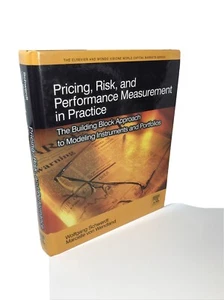Picture 1 of 12












Gallery
Picture 1 of 12












Have one to sell?
Pricing, Risk, and Performance Measurement in Practice: By Wolfgang Schwerdt
US $62.00
ApproximatelyS$ 79.91
Condition:
“Very Good hardcover. Clean, tight, no markings, Small bit of shelf wear: Light bump to the tips ”... Read moreabout condition
Very Good
A book that has been read but is in excellent condition. No obvious damage to the cover, with the dust jacket included for hard covers. No missing or damaged pages, no creases or tears, and no underlining/highlighting of text or writing in the margins. May be very minimal identifying marks on the inside cover. Very minimal wear and tear.
Oops! Looks like we're having trouble connecting to our server.
Refresh your browser window to try again.
Shipping:
Free USPS Media MailTM.
Located in: Boston, Massachusetts, United States
Delivery:
Estimated between Thu, 9 Oct and Tue, 14 Oct
Returns:
60 days return. Buyer pays for return shipping. If you use an eBay shipping label, it will be deducted from your refund amount.
Coverage:
Read item description or contact seller for details. See all detailsSee all details on coverage
(Not eligible for eBay purchase protection programmes)
Seller assumes all responsibility for this listing.
eBay item number:157368861824
Item specifics
- Condition
- Very Good
- Seller Notes
- Field of Study
- Business, Economy & Industry
- Educational Level
- Adult & Further Education, High School, College, University
- Features
- Hardcover, Illustrated
- Level
- Advanced, Business, Technical
- Country/Region of Manufacture
- United States
- Modified Item
- No
- ISBN
- 9780123745217
About this product
Product Identifiers
Publisher
Elsevier Science & Technology
ISBN-10
0123745217
ISBN-13
9780123745217
eBay Product ID (ePID)
73713557
Product Key Features
Number of Pages
398 Pages
Publication Name
Pricing, Risk, and Performance Measurement in Practice : The Building Block Approach to Modeling Instruments and Portfolios
Language
English
Subject
Banks & Banking, Finance / General, Econometrics
Publication Year
2009
Type
Textbook
Subject Area
Business & Economics
Series
The Elsevier and Mondo Visione World Capital Markets Ser.
Format
Hardcover
Dimensions
Item Length
9.2 in
Item Width
7.5 in
Additional Product Features
Intended Audience
Scholarly & Professional
LCCN
2009-015467
Dewey Edition
22
Illustrated
Yes
Dewey Decimal
330.01/5195
Table Of Content
PART I 1.0 Foreword 6002.0 Introduction to Pricing, Risk and Performance Measurement 6002.01 Who is the book for? 5002.02 Foundations of Pricing 1,5002.03 Risk Measurement Basics 1,5002.04 Understanding Performance measurement 1,500 PART II 3.0 Approaches to Pricing 60004.0 Pricing Fixed Cash flows 10,0005.0 Pricing Equity Cash flows 10,0006.0 Pricing Derivative Cash flows 10,0007.0 Putting it All Together: Pricing Complex Instruments 5,000 PART III 8.0 Approaches to Risk Measurement 10,0009.0 Implementing VAR Risk Measurement 8,00010.0 Implementing ETL Risk Measurement 8,00011.0 Implementing Risk Measurement Reports 5,000 PART IV 12.0 Approaches to Performance Measurement 10,00013.0 Implementing Portfolio Performance Measurement 10,00014.0 Implementing Risk Adjusted Profit Measures 10,000
Synopsis
How can managers increase their ability to calculate price and risk data for financial instruments while decreasing their dependence on a myriad of specific instrument variants? Wolfgang Schwerdt and Marcelle von Wendland created a simple and consistent way to handle and process large amounts of complex financial data. By means of a practical framework, their approach analyzes market and credit risk exposure of financial instruments and portfolios and calculates risk adjusted performance measures. Its emphasis on standardization yields significant improvements in speed and accuracy. Schwerdt and von Wendland's focus on practical implementation directly addresses limitations imposed by the complex and costly processing time required for advanced risk management models and pricing hundreds of thousands of securities each day. Their many examples and programming codes demonstrate how to use standards to build financial instruments, how to price them, and how to measure the risk and performance of the portfolios that include them. Feature: The authors have designed and implemented a standard for the description of financial instruments Benefit: The reader can rely on accurate and valid information about describing financial instruments Feature: The authors have developed an approach for pricing and analyzing any financial instrument using a limited set of atomic instruments Benefit: The reader can use these instruments to define and set up even very large numbers of financial instruments. Feature: The book builds a practical framework for analysing the market and credit risk exposure of financial instruments and portfolios Benefit: Readers can use this framework today in their work and identify and measure market and credit risk using a reliable method., How can managers increase their ability to calculate price and risk data for financial instruments while decreasing their dependence on a myriad of specific instrument variants? Wolfgang Schwerdt and Marcelle von Wendland created a simple and consistent way to handle and process large amounts of complex financial data. By means of a practical framework, their approach analyzes market and credit risk exposure of financial instruments and portfolios and calculates risk adjusted performance measures. Its emphasis on standardization yields significant improvements in speed and accuracy.Schwerdt and von Wendland's focus on practical implementation directly addresses limitations imposed by the complex and costly processing time required for advanced risk management models and pricing hundreds of thousands of securities each day. Their many examples and programming codes demonstrate how to use standards to build financial instruments, how to price them, and how to measure the risk and performance of the portfolios that include them.
LC Classification Number
HB139.S39 2009
Item description from the seller
Seller feedback (390)
- eBay automated feedback- Feedback left by buyer.Past monthOrder delivered on time with no issues
- eBay automated feedback- Feedback left by buyer.Past monthOrder delivered on time with no issues
- eBay automated feedback- Feedback left by buyer.Past monthOrder delivered on time with no issues